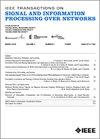RNGCNs:存在缺失数据和大噪声的鲁棒范数图卷积网络
IF 3
3区 计算机科学
Q2 ENGINEERING, ELECTRICAL & ELECTRONIC
IEEE Transactions on Signal and Information Processing over Networks
Pub Date : 2025-07-10
DOI:10.1109/TSIPN.2025.3588087
引用次数: 0
摘要
图卷积网络(GCNs)在属性图数据学习中得到了广泛的研究。在许多应用程序中,图节点属性/特征可能包含各种各样的噪声,例如总损坏和缺失值。现有的图卷积(GCs)通常侧重于结构化图上的特征传播,它无法处理缺失值的图数据,并且容易受到较大的特征误差/噪声的影响。为了解决这个问题,在本文中,我们建议将鲁棒范数特征学习机制纳入图卷积中,并针对存在特征噪声和缺失值的图数据提出鲁棒范数图卷积(RNGCs)。我们的RNGCs是基于从“图上数据重建”的传播函数方面对gc的解释而提出的。在此基础上,我们利用基于鲁棒范数的传播函数推导出RNGCs。最后,我们将衍生的RNGCs整合到端到端网络架构中,并提出了用于图数据学习的各种RNGCs。在多个噪声数据集上的实验结果证明了该方法的有效性和鲁棒性。本文章由计算机程序翻译,如有差异,请以英文原文为准。
RNGCNs: Robust Norm Graph Convolutional Networks in the Presence of Missing Data and Large Noises
Graph Convolutional Networks (GCNs) have been widely studied for attribute graph data learning. In many applications, graph node attributes/features may contain various kinds of noises, such as gross corruption and missing values.Existing graph convolutions (GCs) generally focus on feature propagation on structured-graph which i) fail to address the graph data with missing values and ii) often perform susceptibility to large feature errors/noises. To address this issue, in this paper, we propose to incorporate robust norm feature learning mechanism into graph convolution and present Robust Norm Graph Convolutions (RNGCs) for graph data in the presence of feature noises and missing values. Our RNGCs are proposed based on the interpretation of GCs from a propagation function aspect of ‘data reconstruction on graph’. Based on it, we then derive our RNGCs by exploiting robust norm based propagation functions into GCs. Finally, we incorporate the derived RNGCs into an end-to-end network architecture and propose kinds of RNGCNs for graph data learning. Experimental results on several noisy datasets demonstrate the effectiveness and robustness of the proposed RNGCNs.
求助全文
通过发布文献求助,成功后即可免费获取论文全文。
去求助
来源期刊

IEEE Transactions on Signal and Information Processing over Networks
Computer Science-Computer Networks and Communications
CiteScore
5.80
自引率
12.50%
发文量
56
期刊介绍:
The IEEE Transactions on Signal and Information Processing over Networks publishes high-quality papers that extend the classical notions of processing of signals defined over vector spaces (e.g. time and space) to processing of signals and information (data) defined over networks, potentially dynamically varying. In signal processing over networks, the topology of the network may define structural relationships in the data, or may constrain processing of the data. Topics include distributed algorithms for filtering, detection, estimation, adaptation and learning, model selection, data fusion, and diffusion or evolution of information over such networks, and applications of distributed signal processing.
 求助内容:
求助内容: 应助结果提醒方式:
应助结果提醒方式:


